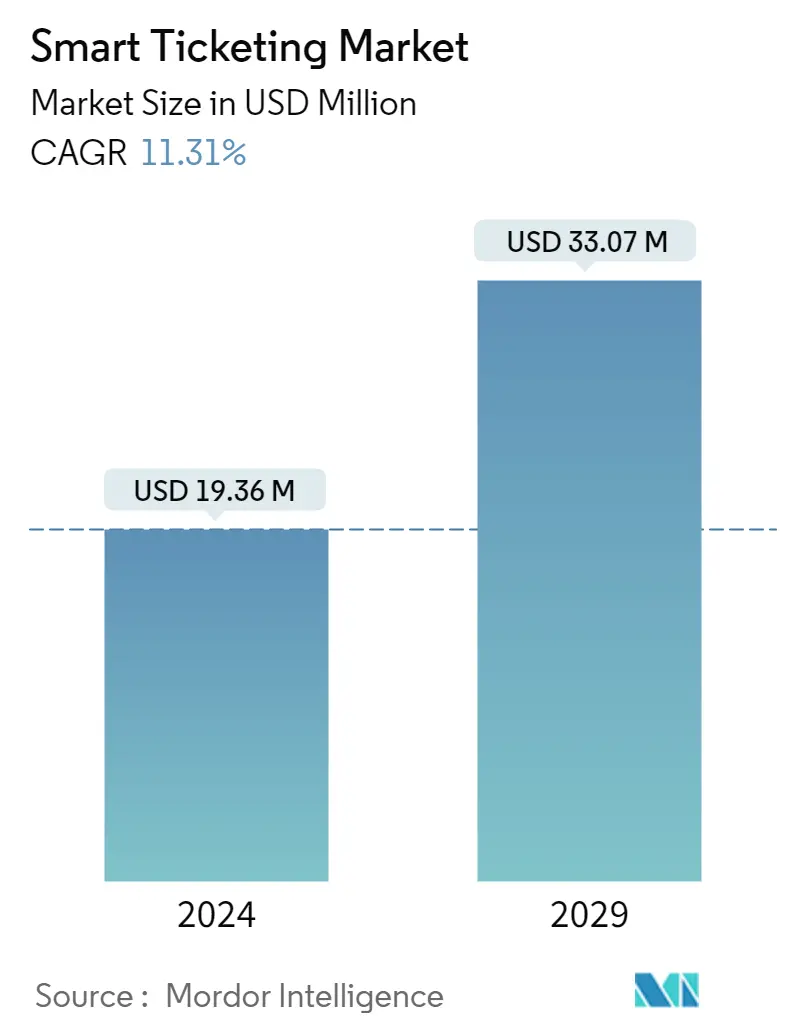Market Size of Smart Ticketing Industry

| Study Period | 2021 - 2029 |
| Market Size (2024) | USD 19.36 Million |
| Market Size (2029) | USD 33.07 Million |
| CAGR (2024 - 2029) | 11.31 % |
| Fastest Growing Market | Asia-Pacific |
| Largest Market | Europe |
Major Players
*Disclaimer: Major Players sorted in no particular order |
Need a report that reflects how COVID-19 has impacted this market and its growth?
Smart Ticketing Market Analysis
The Smart Ticketing Market size is estimated at USD 19.36 million in 2024, and is expected to reach USD 33.07 million by 2029, growing at a CAGR of 11.31% during the forecast period (2024-2029).
Smart tickets, as a substitute for traditional paper-based ticketing, gained traction recently due to the emphasis on digitizing ticketing processes. Smart tickets can save a passenger's time by eliminating the need to wait in line to buy a ticket. Also, covering both smartcards and apps on mobile phones, the technology evolved significantly and emerged as a better alternative to paper tickets.
- Widely used across different forms of transportation, the use cases are increasing across sports and entertainment events. One such example of a use case is the city of Rio de Janeiro, which hosted the Olympic Games and anticipated 500,000 foreign visitors. The public transport ticketing displayed the contactless technology of Gemalto. The company supplied its waterproof 'Celego Contactless Wristband' and its 'Celego Contactless Sticker,' embedded with a contactless chip from Gemalto and certified by Visa and MasterCard. Also, activated with a wave of the wristband near the contactless readers, the solution was one of the major innovations introduced in the region to improve the infrastructure.
- Regional governments are even reaching new milestones in terms of the usage of smart tickets. For instance, according to the Rail Delivery Group (RDG), a British rail industry membership body, more train journeys were made with smart tickets, reaching 65 million. Compared to four weeks from August to September 2019, with the same period in 2018, about 8.4 million more journeys were made with a smart ticket. The RDG data also reveals that passengers chose smart tickets for 50% of all trips, significantly increasing from 37% a year ago.
- The trend of mobile ticketing is also becoming popular among several sports and entertainment events. Several prominent American Football stadiums and associated sports teams implemented mobile ticketing in Europe. With fans entering stadiums via mobile access provisions, this trend is expected to gain traction in Europe. Such increasing interest may challenge the growth of smartcards over the forecast period.
- Rambus, a prominent company in the market, predicts that mobile may become a critical factor for the future of public transport. Furthermore, smart and mobile ticketing can support a better transport experience and improve efficiency during peak times. For instance, the iMOVE testbed in Melbourne, Australia, aims to create a user-focused transport system more responsive to disruption, which can be possible by collecting data from cars, cyclists, public transport, traffic infrastructure, and pedestrians. Other cities, including the United Kingdom, are also expected to take a similar approach.
- Since the pandemic struck, contactless fare payments have become the norm. The increasing adoption of more brilliant payments has enabled safe, seamless travel. As the world is continuously fighting the rapid spread of the COVID-19 pandemic, contactless payments in transportation applications are playing a very crucial role in helping to safeguard people and ensuring to protect that vehicle operator from collecting fares while avoiding close contact with riders.
